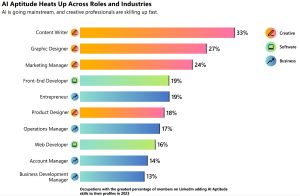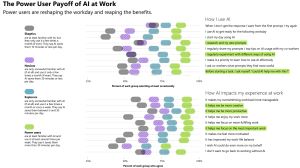News
State of AI at Work: AI-Hungry Power Users 'Won't Wait'
Microsoft and its LinkedIn social media platform published a 2024 Work Trend Index delving into the "state of AI at work," finding that employees are increasingly hungry for AI tools and won't wait for their employers to provide them.
The fourth annual index report, released today, is based on a survey of more than 31,000 people in 31 markets, along with analysis of trillions of data points from LinkedIn and Microsoft 365 and further augmented by Fortune 500 customer research.
"Employees want AI at work -- and won't wait for companies to catch up," is the first key finding of the report.
The
report finds stressed and overwhelmed employees -- 75 percent using AI at work -- indicate the tools save time, boost creativity and sharpen focus on the important stuff.
On the employer flip side:
- 79 percent of leaders agree AI adoption is critical to remain competitive
- 59 percent worry about quantifying the productivity gains of AI
- 60 percent worry their company lacks a vision and plan to implement it
"While leaders feel the pressure to turn individual productivity gains into organizational impact, employees aren't waiting to reap the benefits: 78 percent of AI users are bringing their own AI tools to work. The opportunity for every leader is to channel this momentum into ROI," Microsoft said.
The business/ROI angle was further emphasized by Satya Nadella, chairman and CEO of Microsoft. "AI is democratizing expertise across the workforce," he said. "Our latest research highlights the opportunity for every organization to apply this technology to drive better decision-making, collaboration -- and ultimately business outcomes."
However, the report indicates many leaders aren't taking advantage of that opportunity mentioned by Nadella. Data points that show leaders are lagging behind employees in AI adoption include:
- 45 percent of US executives are not currently investing in AI tools or products for employees.
- Only 39 percent of people globally who use AI at work have gotten AI training from their company.
- Only 25 percent of companies are planning to offer training on generative AI this year, further cementing this training deficit.
So what are those impatient and AI-hungry employees doing while they wait for their employers/leaders to catch up?
Microsoft said that without guidance or clearance from the top, employees are taking things into their own hands and keeping AI use under wraps:
- As noted above, while 78 percent of AI users are bringing their own AI tools to work (BYOAI) -- it's even more common at small and medium-sized companies (80 percent).
- And it's not just Gen Z -- BYOAI cuts across all generations.
- 52 percent of people who use AI at work are reluctant to admit to using it for their most important tasks.
- 53 percent of people who use AI at work worry that using it on important work tasks makes them look replaceable.
Here are summaries of two other key findings, as presented by Microsoft.
No. 2: For employees, AI raises the bar and breaks the career ceiling
"Some are itching for a career change, and there is a massive opportunity for those willing to skill up on AI," the report said.
While AI aptitude heats up across roles and industries as AI goes mainstream, creative professionals -- especially content writers and graphic designers -- are leading the charge.
 [Click on image for larger view.] Occupations with the greatest percentage of members on LinkedIn adding AI Aptitude skills to their profiles in 2023 (source: Microsoft).
[Click on image for larger view.] Occupations with the greatest percentage of members on LinkedIn adding AI Aptitude skills to their profiles in 2023 (source: Microsoft).
Furthermore:
- Leaders are hiring: The majority (55 percent) of leaders say they're concerned about having enough talent to fill roles in the year ahead. These leaders sit across functions, but the number jumps to 60 percent or higher for those in cybersecurity, engineering, and creative design.
- Professionals are looking: While some professionals worry AI will replace their job (45 percent), about the same share (46 percent) say they're considering quitting in the year ahead -- higher than the 40 percent who said the same ahead of 2021's Great Reshuffle. And in the US, LinkedIn studies show a 14 percent increase in job applications per role since last fall, with 85 percent of professionals considering a new job this year.
"Leaders have already made their landgrab for technical AI talent, with hiring up 323 percent in the past eight years. Now they're turning their sights to non-technical talent with AI aptitude -- the skills to use generative AI tools like ChatGPT and Copilot," the report said, listing these data points to back that up:
- 66 percent of leaders say they would not hire someone without AI skills.
- 71 percent say they'd rather hire a less experienced candidate with AI skills than a more experienced candidate without.
- There was a 142x increase in skills like Copilot and ChatGPT added to LinkedIn profiles last year.
No. 3: The rise of the AI power user -- and what they reveal about the future.
The report found four main types of AI users, ranking from skeptics to novices to explorers to power users, with the No. 1 predictor of the latter being frequent experimentation with AI.
Findings associated with that key takeaway include:
- Power users are familiar to extremely familiar with AI, using it at work at least several times a week and saving more than 30 minutes a day. And it's paying off: power users say AI makes their overwhelming workload more manageable (92 percent), boosts their creativity (92 percent), and helps them focus on the most important work (93 percent) -- and it helps them feel more motivated (91 percent) and enjoy work more (91 percent).
- The path to becoming a power user starts with developing new habits. Power users are 68 percent more likely to frequently experiment with different ways of using AI--in fact, it's the #1 predictor of whether someone will be a power user or not. When compared to other survey respondents, they're also more likely to frequently pause before a task and ask themselves if AI can help (+49 percent), to keep trying if they don't get the perfect response the first time (+30 percent), and to research and try new prompts (+56 percent). Power users also bookend their day with AI -- using it to start the day (85 percent) and get ready for the following workday (85 percent).
- Power users have also reoriented their work patterns in fundamental ways. They are 56 percent more likely to use AI to catch up on missed meetings, to analyze information (+51 percent), to design visual content (+49 percent), to interact with customers (+49 percent), and to brainstorm or problem-solve (+37 percent). And they're already moving past individual tasks: they're 66 percent more likely to redesign their business processes and workflows with AI.
The graphic below illustrates responses to the questions:
- When using artificial intelligence (AI) at work, how frequently do you do each of the following?
- We'd now like you to reflect on how you feel about using artificial intelligence (AI) in your work.
- To what extent do you agree or disagree with the following statements?
 [Click on image for larger view.] Power User Payoff (source: Microsoft).
[Click on image for larger view.] Power User Payoff (source: Microsoft).
Data points show that power users are empowered by a different kind of organization. At their companies:
- Senior leaders lean in: AI power users are 61 percent more likely to hear from their CEO about the importance of using generative AI at work, 40 percent more likely to hear from the leader of their department, and 42 percent more likely to hear from their manager's manager.
- Company culture is change-ready: AI power users are 53 percent more likely to receive encouragement from leadership to consider how AI can transform their function, and 18 percent more likely to say their company encourages innovation.
- They get tailored training: AI power users are 37 percent more likely to say their company has a virtual learning program. They're also more likely to have received training on prompt writing (+37 percent), how to use AI for their role or function (+35 percent), or specific use cases such as writing or analyzing data (+32 percent).
"AI power users provide a window into the future -- revealing what's possible when employees embrace new ways of working and leaders lean in" the report said.
Get Started
The report also indicated how organizations can get started to capitalize on the the opportunity for leaders to channel employee enthusiasm for AI into business transformation:
- Identify a business problem, then apply AI: There are efficiency gains to be had across every function-- the key is to pick a process and apply AI. For example, start with customer service and focus on improving call handling time. Global advertising network dentsu applied AI to its creative development process. Estée Lauder is using it to reimagine product development and customer experience.
- Take a top-down, bottom-up approach: Going from experimentation to transformation requires engagement at every level of the organization, from the CEO to the entry-level employee. Business gains will come when you enlist your business line leaders to activate teams around AI. As we've rolled out Copilot at Microsoft, we've relied on internal champions at all levels to model and spread AI enthusiasm and aptitude.
- Prioritize training: AI power users aren't doing it on their own -- they receive ongoing training, both on universal tasks and uses more tailored to their role and function. LinkedIn Learning is a great place to start to skill up, and the Copilot Scenario Library provides use cases for specific roles and functions.
Copilot Innovations Coming Up
In the blog post about the new report, Microsoft teased upcoming innovations coming up in Copilot for Microsoft 365 while noting, "The prompt box is the new blank page."
"We hear one consistent piece of feedback from our customers: talking to AI is harder than it seems," the company said. "We've all learned how to use a search engine, identifying the right few words to get the best results. AI requires more context -- just like when you delegate work to a direct report or colleague. But for many, staring down that empty prompt box feels like facing a blank page: Where should I even start?"
Upcoming innovations will include:
- If you've got the start of a prompt, Copilot will offer to auto-complete it to get to a better result, suggesting something more detailed to help ensure you get what you're looking for. That not only speeds things up, it offers you new ideas for how to leverage Copilot's power.
- Other times, you know exactly what you want -- you're just not sure how to ask. With its new rewrite feature, Copilot turns a basic prompt into a rich one with the click of a button, turning everyone into a prompt engineer.
- Catch Up, a new chat interface that surfaces personal insights based on your recent activity, provides responsive recommendations, like "You have a meeting with the sales VP on Thursday. Let's get you prepared -- click here to get detailed notes."
- We also know that every role, team and function has unique needs and ways of working. To help create prompts for exactly the work you do, you'll soon be able to create, publish and manage prompts in Copilot Lab that are expressly tailored to your closest teams.
Microsoft also set up a 2024 Annual Work Trend Index microsite that contains related blogs, videos and assets.